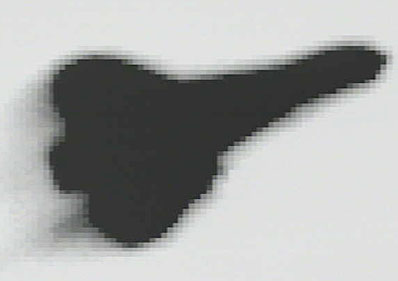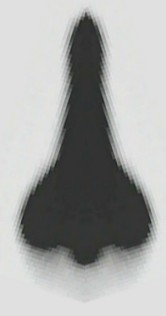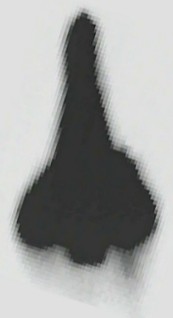
Image of Columbia from Air Force. Photo: NASA TV
Posted on 02/07/2003 4:08:42 PM PST by Lokibob
 Image of Columbia from Air Force. Photo: NASA TV |
According to sources close to the investigation, the images, under analysis at the Johnson Space Center in Houston, show a jagged edge on the left inboard wing structure near where the wing begins to intersect the fuselage. They also show the orbiter's right aft yaw thrusters firing, trying to correct the vehicle's attitude that was being adversely affected by the left wing damage. Columbia's fuselage and right wing appear normal. Unlike the damaged and jagged left wing section, the right wing appears smooth along its entire length. The imagery is consistent with telemetry.
The ragged edge on the left leading edge, indicates that either a small structural breach -- such as a crack -- occurred, allowing the 2,500F reentry heating to erode additional structure there, or that a small portion of the leading edge fell off at that location.
Either way, the damage affected the vehicle's flying qualities as well as allowed hot gases to flow into critical wing structure -- a fatal combination.
It is possible, but yet not confirmed, that the impact of foam debris from the shuttle's external tank during launch could have played a role in damage to the wing leading edge, where the deformity appears in USAF imagery.
If that is confirmed by the independent investigation team, it would mean that, contrary to initial shuttle program analysis, the tank debris event at launch played a key role in the root cause of the accident.
Another key factor is that the leading edge of the shuttle wing where the jagged shape was photographed transitions from black thermal protection tiles to a much different mechanical system made of reinforced carbon-carbon material that is bolted on, rather than glued on as the tiles are.
This means that in addition to the possible failure of black tile at the point where the wing joins the fuselage, a failure involving the attachment mechanisms for the leading edge sections could also be a factor, either related or not to the debris impact. The actual front structure of a shuttle wing is flat. To provide aerodynamic shape and heat protection, each wing is fitted with 22 U-shaped reinforced carbon-carbon (RCC) leading-edge structures. The carbon material in the leading edge, as well as the orbiter nose cap, is designed to protect the shuttle from temperatures above 2,300F during reentry. Any breach of this leading-edge material would have catastrophic consequences.
The U-shaped RCC sections are attached to the wing "with a series of floating joints to reduce loading on the panels due to wing deflections," according to Boeing data on the attachment mechanism.
"The [critical heat protection] seal between each wing leading-edge panel is referred to as a 'tee' seal," according to Boeing, and are also made of a carbon material.
The tee seals allow lateral motion and thermal expansion differences between the carbon sections and sections of the orbiter wing that remain much cooler during reentry.
In addition to debris impact issues, investigators will likely examine whether any structural bending between the cooler wing structure and the more-than-2,000F leading edge sections could have played a role in the accident. There is insulation packed between the cooler wing structure and the bowl-shaped cavity formed by the carbon leading-edge sections.
The RCC leading-edge structures are bolted to the wing using Inconel fittings that attach to aluminum flanges on the front of the wing.
The initial NASA Mission Management Team (MMT) assessment of the debris impact made Jan. 18, two days after launch, noted "The strike appears to have occurred on or relatively close to the "wing glove" near the orbiter fuselage.
The term "wing glove" generally refers to the area where the RCC bolt-on material is closest to the fuselage. This is also the general area where USAF imagery shows structural damage.
The second MMT summary analyzing the debris hit was made on Jan. 20 and had no mention of the leading-edge wing glove area. That report was more focused on orbiter black tiles on the vehicle's belly. The third and final summary issued on Jan. 27 discusses the black tiles again, but also specifically says "Damage to the RCC [wing leading edge] should be limited to [its] coating only and have no mission impact." Investigators in Houston are trying to match the location of the debris impact with the jagged edge shown in the Air Force imagery.
Columbia reentry accident investigators are also trying to determine if, as in the case of the case of Challenger's accident 17 years ago, an undesirable materials characteristic noted on previous flights -- in this case the STS-112 separation of external tank insulation foam debris -- was misjudged by engineers as to its potential for harm, possibly by using analytical tools and information inadequate to truly identify and quantify the threat to the shuttle. As of late last week, NASA strongly asserted this was not the case, but intense analysis on that possibility continues.
The shuttle is now grounded indefinitely and the impact on major crew resupply and assembly flights to the International Space Station remain under intense review.
Killed in the accident were STS-107 Mission Commander USAF Col. Rick Husband; copilot Navy Cdr. William McCool; flight engineer, Kalpana Chawla; payload commander, USAF Lt. Col. Michael Anderson; mission specialist physician astronauts Navy Capt. Laurel Clark and Navy Capt. David Brown and Israeli Air Force Col. Ilan Ramon.
"We continue to recover crew remains and we are handling that process with the utmost care, the utmost respect and dignity," said Ronald Dittemore, shuttle program manager.
No matter what the investigations show, there are no apparent credible crew survival options for the failure Columbia experienced. With the ISS out of reach in a far different orbit, there were no credible rescue options if even if wing damage had been apparent before reentry -- which it was not.
If, in the midst of its 16-day flight, wing damage had been found to be dire, the only potential -- but still unlikely -- option would have been the formulation over several days by Mission Control of a profile that could have, perhaps, reduced heating on the damaged wing at the expense of the other wing for an unguided reentry, with scant hope the vehicle would remain controllable to about 40,000 ft., allowing for crew bailout over an ocean.
Reentry is a starkly unforgiving environment where three out of the four fatal manned space flight accidents over the last 35 years have occurred.
These include the Soyuz 1 reentry accident that killed cosmonaut Vladimir Komarov in 1967 and the 1971 Soyuz 11 reentry accident that killed three cosmonauts returning after the first long-duration stay on the Salyut 1 space station.
The only fatal launch accident has been Challenger in 1986, although Apollo astronauts Gus Grissom, Ed White and Roger Chaffee were killed when fire developed in their spacecraft during a launch pad test not involving launch.
No other accident in aviation history has been seen by so many eyewitnesses than the loss of Columbia -- visible in five states.
Telemetry and photographic analysis indicate the breakup of the historic orbiter took place as she slowed from Mach 20-to-18 across California, Nevada, Arizona and New Mexico with the loss of structural integrity 205,000 ft. over north central Texas where most of the debris fell.
The science-driven STS-107 crew was completing 16 days of complex work in their Spacehab Research Double module and were 16 min. from landing at Kennedy when lost. Landing was scheduled for 8:16 a.m. CST.
Abnormal telemetry events in the reentry began at 7:52 a.m. CST as the vehicle was crossing the coast north of San Francisco at 43 mi. alt., about Mach 20.
The orbiter at this time was in a 43-deg. right bank completing its initial bank maneuver to the south for initial energy dissipation and ranging toward the Kennedy runway still nearly 3,000 mi. away.
That initial bank had been as steep as about 80 deg. between Hawaii and the California coast, a normal flight path angle for the early part of the reentry. The abnormal events seen on orbiter telemetry in Houston indicate a slow penetration of reentry heat into the orbiter and damage on the wing, overpowering the flight control system. Key events were:
But the rate of left roll was beginning to overpower the elevons, so the control system fired two 870-lb. thrust right yaw thrusters to help maintain the proper flight path angle. The firing lasted 1.5 sec. and, along with the tire pressure data and elevon data, would have been noted by the pilots.
At about this time, the pilots made a short transmission that was clipped and essentially unintelligible
In Mission Control, astronaut Marine Lt. Col. Charles Hobaugh, the spacecraft communicator on reentry flight director Leroy Cain's team, radioed "Columbia we see your tire pressure [telemetry[ messages and we did not copy your last transmission."
One of the pilots then radioed "Roger," but appeared to be cut off in mid transmission by static. For a moment there was additional static and sounds similar to an open microphone on Columbia but no transmissions from the crew.
All data from the orbiter then stopped and the position plot display in Mission Control froze over Texas, although an additional 30 sec. of poor data may have been captured.
Controllers in Mission Control thought they were experiencing an unusual but non-critical data drop out. But they had also taken notice of the unusual buildup of sensor telemetry in the preceding few minutes.
About 3 min. after all data flow stopped, Hobaugh in mission control began transmitting in the blind to Columbia on the UHF backup radio system. "Columbia, Houston, UHF comm. check" he repeated every 15-30 sec., but to no avail. In central Texas, thousands of people at that moment were observing the orbiter break up at Mach 18.3 and 207,000 ft.
Milt Heflin, Chief of the Flight Director's office said he looked at the frozen data plots. "I and others stared at that for a long time because the tracking ended over Texas. It just stopped. It was was then that I reflected back on what I saw [in Mission Control] with Challenger."
The loss of Challenger occurred 17 years and four days before the loss of Columbia.
"Our landscape has changed," Heflin said. "The space flight business today is going to be much different than yesterday.
"It was different after the Apollo fire, it was different after Challenger."
Columbia, the first winged reusable manned spacecraft first launched in April 1981, was lost on her 28th mission on the 113th shuttle flight.
No, they look more like a resolution effect. Only up near the wing root, but not quite up to it, does anything look amiss. Plus there seems to be a streak trailing behind the shuttle that lines up with that same location.
No, this isn't the picture that the astronomer in San Francisco shot- this is from an Air Force ground based tracking facility, as per the article.
Given the circumstances under which it was taken, it isn't too bad, and it does tell us things.
Telemetry and photographic analysis indicate the breakup of the historic orbiter took place as she slowed from Mach 20-to-18 across California, Nevada, Arizona and New Mexico with the loss of structural integrity 205,000 ft. over north central Texas where most of the debris fell.
It's a tracking camera. No color information is needed. It's an extreme enlargement of a small portion of a digital photo. That's why the pixelation is so extreme.
Well tell us .. cause I don't have the slightest idea
"What damage???"
Well you may get dropped kicked back into Utaw, as I believe he turned then into NASA instead of running to the networks like a media hound. I thinks this possibly makes him even more credible.
According to sources close to the investigation, the images, under analysis at the Johnson Space Center in Houston, show a jagged edge on the left inboard wing structure near where the wing begins to intersect the fuselage. They also show the orbiter's right aft yaw thrusters firing, trying to correct the vehicle's attitude that was being adversely affected by the left wing damage. Columbia's fuselage and right wing appear normal. Unlike the damaged and jagged left wing section, the right wing appears smooth along its entire length. The imagery is consistent with telemetry.
Also consider how far out the were when this was shot. Continuing...
as the crippled orbiter flew overhead about 60 sec. before the vehicle broke up over Texas
Sixty seconds from Texas at 12K MPH, is what- over California? Over the Pacific?
It also lends a lot of weight to the notion that it was in fact a wing problem, rather than some as yet unspecified event, per some of the speculation.


An aircraft doesn't "roll" left or right. It "yaws." "Roll" indicates a rotational motion around the longitudinal axis. Was Columbia rolling or yawing at 7:59 when the thrusters fired? A roll would be a much harder aerodynamic event to counteract, and a much more destabilizing one in such a cumbersome vehicle, I would think. However, a yaw is more consistent with asymmetric damage to a flight surface, where said damage would impart adverse drag.
But to the degree the stubby wings of the shuttle are lifting surfaces, damage to the left leading edge could have diminished that wing's lift, causing both yaw and roll.
This timeline, while fascinating, simply tells the "what," not the "why."
Disclaimer: Opinions posted on Free Republic are those of the individual posters and do not necessarily represent the opinion of Free Republic or its management. All materials posted herein are protected by copyright law and the exemption for fair use of copyrighted works.